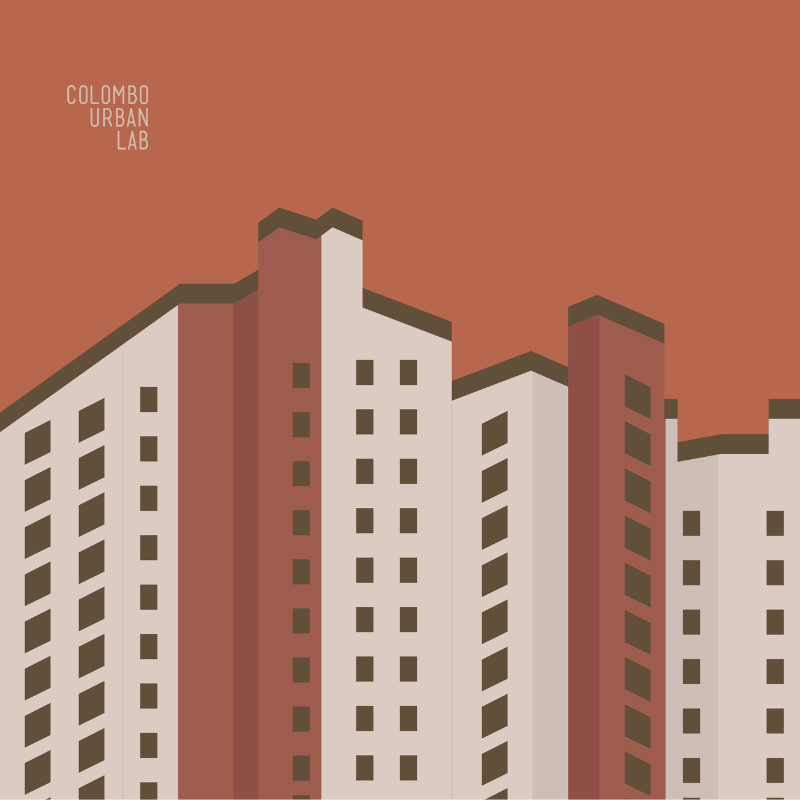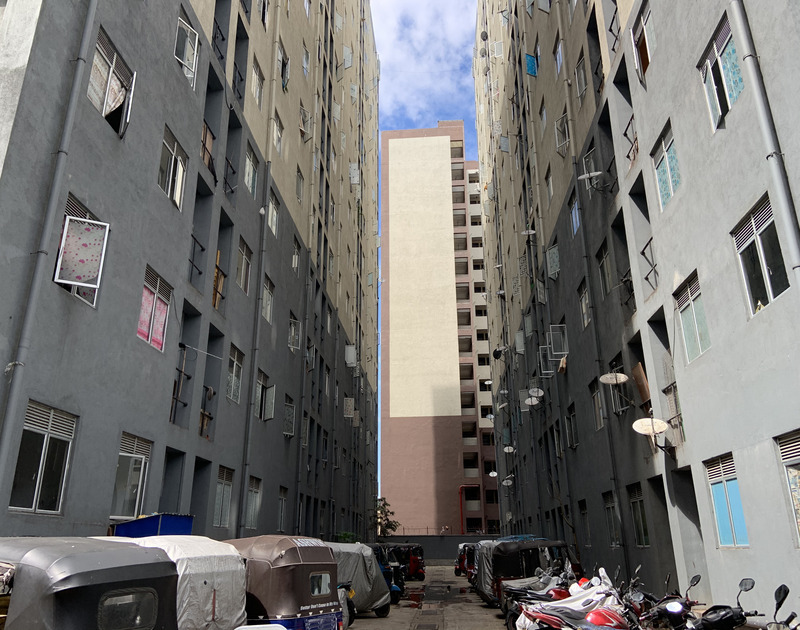
- Home
- Knowledge Insights
- Webinar: Debt without development
The recording of the webinar can be viewed here.
Colombo Urban Lab hosted Professor Jonathan Spencer from the University of Edinburgh and Dr. Avanka Fernando from the University of Colombo on the 16th of January 2025 in an online event titled “Debt without Development? Sri Lanka’s Urban Regeneration Project’s Failed Promises”. The guests shared their insight on Sri Lanka’s development projects and debt, and the impact of the Colombo Urban Regeneration Project on the primary stakeholders, the local community. Alongside the discussion, a review of the key insights from the report, “Built on Sand: Colombo’s Urban Regeneration Project” was presented by the Colombo Urban Lab team.
Many post-war development projects in Sri Lanka are heavily criticised for the debt incurred, lack of due process and often cited as white elephant projects funded by Chinese loans. However, unlike infrastructure projects like the Mattala International Airport and the Sooriyaweva Cricket Stadium, the Urban Regeneration Project (URP) implemented by the Urban Development Authority (UDA) is often overlooked. The URP has invested LKR 60 billion from 2010 to 2018, costing the country twice as much as the Mattala International Airport and four times as much as the Lotus Tower. In addition to the monetary cost of the project, it is mired in lack of transparency, due process and heavy social cost. The project continues now with a USD 200 million loan from the Asian Infrastructure Investment Bank (AIIB) and the principal repayment dates of the loan are to begin on the 15th of November 2027 with instalment shares of 2.27% to be paid off through 15th November 2048.
The event opened with Meghal Perera from Colombo Urban Lab outlining the economic and social cost of the project including its flawed financial model, failure to generate income and forced relocations among other issues. According to the report, “Built on Sand: Colombo’s Urban Regeneration Project”, the key objective of the URP was to relocate 50% of Colombo’s population that resided in settlements on 9% of the land. Following the relocation of the community to high-rise apartments the URP aimed to free commercially lucrative land. However, the project has failed to generate investment, with many of the vacated lands remaining vacant or under-utilised. Moreover, the project has been characterised by severe delays as well as lack of transparency. Amidst a significant financial cost, the study found that the communities subject to relocation were not consulted, official documents were in languages they could not understand, and families were relocated far away from their original settlement leading to loss of livelihood, education, and sense of belonging. Moreover, the built environment posed challenges as the unit size did not reflect the size of the family, daily wage earners were unable to meet the cost of rent, access to the grid was weaponised against them, a lack of safety for women and girls, poor infrastructure maintenance, rise in drug abuse and mental health issues due to the isolating living environment and breakdown of community life. Many of these issues are unique to the relocated sites and have forced families to abandon the new housing units or move back to the original locations signalling a failure of the project as the social costs far outweigh the benefits.
Responding to the report, Professor Spencer reflected on his initial work on the urban poor in Colombo in 2015, published along with Dr. Harini Amarasuriya. He noted how local officials viewed the URP as a programme to remove unauthorised constructions and improve the standard of living which will bring a sense of “discipline” to the communities. He then commented on the irony of a project focused on the poor’s need for discipline as a means to improvement being based on an entirely undisciplined approach to what may be perceived as financial reality. Correspondingly, Professor Spencer highlighted the financial irresponsibility of the project by noting that the government issued an LKR 10 million bond to repay the previously issued debenture despite an absence of funds generated through the investment. He reflected that although the URP was pitched to the world as an exercise in market driven development, the role of the market was rhetorical, with the project compromising on the economics of real estate development and instead focusing on aesthetics.
Professor Spencer drew attention to recent developments in 2024 where President Ranil Wickremesinghe distributed deeds of ownership to 1000 new residents but an analysis of these documents proved no legal validity. Despite such scenarios indicating underlying political motive, Professor Spencer reminded that from the 1970s to the 2000s Colombo had some of the most progressive policies in the region for the development of low-income housing. In his concluding remarks he encouraged the country to utilise the abundant local expertise and experience to confront the challenges of the future.
Following Professor Spencer’s reflections, Dr. Fernando’s discussion focused on the impact of the URP on the everyday life of the urban working class. Noting how the URP has largely overlooked the social impact of its development, she reiterated the need to study the everyday life of the working class to understand the broader frameworks and structures of global capital and state control but also to look into social structures and communities and how it constructs the intimate aspects of home and community. She shared experiences from her ethnographic fieldwork which involved residing in a UDA-run high-rise apartment. Similar to Professor Spencer, she maintained that the project symbolised development and modern life and the idea that these world class cities brought discipline to the working-class poor but on the other hand reflects precarity, uncertainty, breakdown and accumulating debt which characterises the everyday life of the urban poor. Accordingly, the responses to the URP were classified into passive acceptance and vulnerability, coping strategies and resilience, appropriation of space and lastly defiance and resistance especially among the working class during COVID-19. Dr. Fernando continued to explain that the development disregards the agency and strength of the working class and fails to capture the reality of the community. In her concluding remarks, Dr. Fernando emphasised that in failing to consult the people for the URP, the danger and poverty of the working-class communities worsened, and she suggested that development narratives, including the concept of a greater good need to be questioned and interrogated. Following the end of the discussion, Iromi Perera from Colombo Urban Lab added that with each different administration the method of relocation or the mode of operation has become increasingly opaque making it harder for people to access justice and understand injustice.
The Q&A session began with a question about the potential for more organised collective action in the high-rise amidst issues such as debt and grid weaponisation and what strategies might be used in such an instance. To answer this, the discussants shared how the early stages of the project was heavily controlled by the military allowing little opposition but also noted how in the years 2010 to 2011 local political mobilisation through MPs and other parties slowed down the project. However, at present community resistance takes a more complex form because it is affected by factors such as different stages of relocation, construction of many tower blocks with varying design and structure and importantly the dynamics within the community. It was pointed out that despite the AIIB working towards better financial sustainability their model lacked community participation as well leading to poor results. Another participant questioned if and how social infrastructure in the high rises were different to the original settlements.The process of relocation was not consultative nor was attention paid to the lifestyle or the relationships fostered among their traditional communities and settlements compromising social infrastructure and a breakdown in their sense of belonging.
Following this, the discussion shifted to examining issues related to ownership and management of the apartments once the UDA exits. CUL Director, Iromi Perera explained that one of the reasons a condominium management association cannot be set up in the high-rises is because the flats are still owned by the UDA. She noted that a new process being rolled out by the UDA compels households in the process of relocation to form a company limited by guarantee, making residents shareholders as they move into the building and eventually handover ownership within the span of two years. Problematically, these processes are not documented or formally announced to the residents. Lastly, a question addressed the loan provided by the AIIB and how the UDA deals with foreign and local expertise. This explored how although a state institution, the leadership and mode of operation of the UDA changed frequently with each new government. The AIIB offered the loan at a crucial juncture where the URP was to end due to a loss of funds. Although the AIIB brought a limited amount of safeguards to the execution of the project and aimed to correct previous financial errors, they too failed to address community participation and options such as low-rise housing, in-situ housing and providing other choices to the people, repeatedly called for by local experts.
To conclude the session, it was highlighted how development in Colombo has emphasised aesthetics over economy and utility and how the development is rushed and forced. The report reveals several solutions to ease if not correct the issues of the URP and includes recommendations to halt the URP and audit all stages of the project as an immediate action. In the short term, the report recommends the upgrading of existing high-rise apartments to correct design flaws and establishing management committees for the apartments. In the long term, it recommends the investment in participatory and sustainable models of housing and moving away from the high-rise model. Colombo Urban Lab researchers also noted that wattes or settlements can evolve by themselves, and that issues of social infrastructure and low-income can be resolved more meaningfully through mechanisms such as universal social security.


